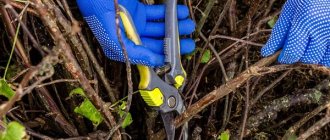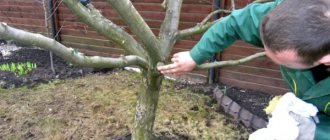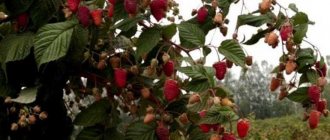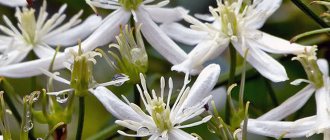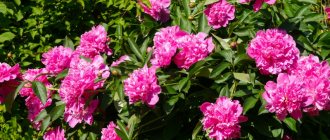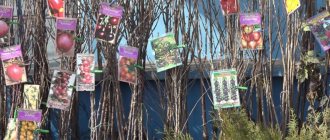Autumn pruning of raspberries
In the autumn months, the fragile shoots of this year and those older than two years are removed from raspberries. Overgrown bushes need to be thinned out. To do this, the lateral processes are cut off.
They are young and light brown in color. This pruning will help the plant survive frost. Also, larger bushes will be easier to harvest and care for next year.
Gardeners recommend removing old leaves from raspberries when pruning. With the onset of rains, they begin to rot and adhere tightly to the flower buds. They are defeated.
They tear off the leaves by hand. To do this, put on thick gloves, clasp the stem with your palm and move it upward. After such manipulations, only young stems should remain on the bushes, without foliage.
Why and when to prune?
Carry out the pruning procedure to:
- give the bushes an aesthetic appearance;
- allow light to penetrate deep into the bush;
- Boost immunity and protect against pests.
If the bushes are not regularly pruned, the fruits on them will become smaller every year. Raspberries should be prepared for frost in late August - early September. Late pruning can harm the plant. By mid-autumn, a large number of pests and various diseases accumulate on the bushes, they reduce the plant’s ability to withstand cold. Some gardeners recommend pruning it immediately after harvest.
Instructions and cutting methods
It is necessary to remove from the plant:
- infected young shoots;
- old stems;
- shoots that prevent the plant from receiving enough light.
After pruning, all branches must be burned. The remaining shoots are treated with copper sulfate, the bush is dug up and fertilized.
There are several pruning methods:
- Regular. All branches are shortened by half, weak shoots are completely removed. If the previous harvest was bad, then the stems are cut off at the root and covered with mulch. But such a drastic method is not suitable for black-fruited varieties. This could lead to no harvest next year.
- Double. The bush is pruned in spring and autumn. This method is more often used in warm regions.
- For shortening. Only the tops of the stems are trimmed.
Planting raspberries in autumn
Contrary to all prejudices, it is better to plant raspberry seedlings in the fall. Compared to those planted in veins, those planted in autumn will produce a larger harvest. However, planting in the fall should be carried out taking into account many factors.
Selecting planting dates
There are no specific landing dates. The planting of seedlings is influenced by location, weather and variety. It is important not to waste time and plant bushes 15 days before the first frost.
To understand whether the seedlings are ready for planting or not, you need to carefully examine the root collar. If there are replacement buds on it, then the seedlings are ready for planting. Early varieties produce replacement buds in the second ten days of September, late varieties - in early October.
Attention!
Planting too late will lead to the death of the bushes; they will not be able to withstand severe frosts.
How to prepare a site for planting raspberries in the fall
Raspberries prefer sunny areas, sheltered from gusty winds. It is recommended to prepare the soil long before the planned planting of seedlings. First, the area needs to be sown with green manure. They improve the soil structure.
For your information!
If nightshade crops or strawberries grew in the designated area, raspberries cannot be planted!
Sandy or loamy soil is ideal for planting. When the soil becomes acidic, liming is recommended.
How not to make a mistake when choosing seedlings
Healthy seedlings are the key to a good harvest. A high-quality seedling should have a well-developed root system, and the shoot itself should be 20 cm long with a diameter of 5 mm.
2 days before planting, the seedlings are immersed in water to absorb moisture. And just before planting, the roots are dipped in mullein infusion diluted with water in a ratio of 1:10.
Planting raspberries using the strip method
This method is considered the most effective. The rows are marked along a stretched rope. There should be a distance of 2 m between the rows. The width and depth of the trench is 40 cm.
Fertilizers are applied to the dug trench (per 1 m2):
- potassium salt – 20 g;
- superphosphate – 20 g;
- manure – 3 kg.
Timing for pruning raspberries
The optimal time for pruning raspberry bushes is August-September. Many gardeners are of the opinion that it is best to carry out manipulation immediately before the onset of winter, but this statement is erroneous.
Such late pruning has a detrimental effect on plants: during the delay of manipulation, pests and diseases actively multiply on the branches, which significantly worsen the condition of the bushes and reduce the likelihood of them overwintering.
Note! It is best to prune raspberries for the winter immediately after picking the last berries.
Rules for caring for raspberries in autumn
Autumn care involves stages. They start working on them after harvesting . This:
- fertilization
- pest control
- pruning and pruning shoots and branches
- mulching the soil
- garter and winter ducking
Fertilizers are needed to ensure that the plant replenishes the necessary nutrients before winter. Pruning and pruning are used to get rid of plant pests and fungi that have settled on the upper parts and leaves of the plant. The main thing is to then remove the cut branches and foliage and burn them . You can also spray against insects.
Pruning removes old unnecessary shoots and limits the height of a mature plant. It is important to monitor the growth of bushes. The distance between them is 60 -70 cm and one and a half meters between the rows. Plants must receive a lot of light to produce a good harvest.
When mulching, the soil is covered with straw, peat, sawdust, and leaves. You can use purchased material. This helps retain moisture in the soil and regulates air and water regimes.
Mulching raspberries helps retain moisture in the soil
Gartering and bending helps the plant to safely survive the winter cold. The bushes are tied into bunches and bent down so that the fallen snow covers them and they do not freeze.
How to prune bushes correctly: instructions and pruning methods
To unlock the full potential that autumn pruning brings, first of all, it must be done correctly.
Proper pruning of raspberries in the fall is carried out as follows:
- Remove dried, diseased and very damaged annual shoots and stems.
- Old 2-year-old shoots are cut off.
- Heavily thickened raspberries need to be thinned out: by 1 sq. m there should be 8-10 stems left.
- To destroy pests, cut branches are piled up and burned.
- The ground near the bushes is carefully dug up and fertilizers are applied;
- The shoots are treated with iron sulfate.
After pruning the raspberries in the fall, healthy shoots should remain, the number of which approximately matches the number of cut branches.
Important! Pruning raspberries in the fall should be done with sharp garden pruners: due to the use of dull knives or scissors, the cut sites take a very long time to heal.
If there is a need for propagation, the shoots near the bushes are dug up and replanted. In cases where the expansion of the raspberry tree is not planned, it is pulled out or cut off.
Protecting raspberry bushes from pests and diseases
Before the start of winter, all raspberry bushes are pruned, leaves and dry fruits are removed. If all the plants are healthy, then this material can be used to make compost. But in most cases, all this is burned off-site.
All raspberry bushes are treated with Bordeaux mixture. This should be done in dry and windless weather.
Features of pruning remontant raspberries for the winter
Raspberries of remontant varieties bear fruit on one-year and two-year-old shoots. The scheme for pruning raspberries of remontant varieties in the fall depends on how much of the crop is planned to be harvested in the next season.
For the purpose of picking berries once, remontant raspberry bushes are pruned for the winter in the same way as regular raspberry varieties: the shoots are completely cut off, leaving only very short shoots near the soil itself.
If you want to get 2 harvests (but less abundant), then you should leave annual shoots.
Description of culture
Raspberry is a perennial shrub with a sinuous, powerful rhizome and numerous terrestrial erect shoots, the height of which can reach 2.5 meters. In the first year of vegetation, the shoots are grassy with thin, barely noticeable thorns. In the second year of life, they turn brown, become woody and begin to bear fruit. After the fruiting period ends, the branches die, and a new stem grows from the root bud in the spring.
Interesting! Raspberries are extremely sweet and aromatic. Depending on their variety, they can be orange, yellow, burgundy, light pink or bright red. The taste of this berry also differs, which can be sickly sweet or slightly sour.
Raspberries are an unpretentious shrub , but achieving good yield, stable growth and the absence of fungal and infectious diseases in this plant can only be achieved by providing them with appropriate proper care. Such bushes will require the greatest attention in the fall, when they need not only to be trimmed correctly, but also fed, covered with mulch or spruce branches, which will allow the plantings to easily endure even frosty winters.
Double trimming
Double pruning of raspberries according to Sobolev has a good effect on yield, according to which ordinary raspberry bushes are pruned according to a certain pattern in May-June for 2 years in a row:
- 1st pruning: the top of stems 70-90 cm high is cut off by 10-15 cm. After manipulation, the plant begins to actively form side stems.
You cannot put off the first pruning for a long time, as the young side shoots will not have time to grow before winter and will freeze out. It is optimal to carry it out around the beginning of summer, that is, in June.
- 2nd pruning: as soon as the first leaves appear on the bush, the top is shortened again by 5-15 cm: even more new stems will form on the bush.
Feeding with fertilizers
Year-round care and nutrition increase crop productivity, strengthen the immune system and protect against diseases and viruses.
Starter fertilizers
When planting in a trench or hole under raspberries, apply the following fertilizers:
- ammonium nitrate - up to 20 g per bush;
- azofoska or nitroammofoska - complex NPK complex (16:16:16) - 30-40 g per 1 seedling;
- additions of boron, zinc and copper are applied simultaneously with basic mineral fertilizers.
Feeding raspberries in winter
Already at the end of summer, in August, you need to pay attention to the raspberries. The nutrient supply in the soil is almost exhausted, the raspberry bushes have wasted a lot of energy. The main thing is not to skip the autumn feeding of raspberries, otherwise you may be left without a harvest.
In the first ten days of August 1-5 and 2 weeks later on August 15-20, it is important to feed raspberries
with mineral fertilizers:
- potassium sulfate - potassium (52%) and sulfur (18%) will protect plants from the upcoming cold weather and ensure the formation of fruit buds in the next season. The irrigation solution is prepared in the proportion of 1 tbsp. l. drug per 10 liters of water ;
- superphosphate extract - 10 tbsp. l. fertilizers per 10 liters of water ; if you fill it with hot water, the hood is ready in a day; if it’s cold, the solution is infused for at least 72 hours (3 days).
How to grow more crops?
Any gardener and summer resident is pleased to receive a large harvest with large fruits. Unfortunately, it is not always possible to obtain the desired result.
Plants often lack nutrition and useful minerals
It has the following properties:
- Allows you to increase yield by 50% in just a few weeks of use.
- You can get a good harvest even on low-fertility soils and in unfavorable climatic conditions
- Absolutely safe
Forming the correct row
Summer residents from the southern regions of the country should form the correct row in the autumn. Raspberries should be planted when a root bud appears. There should be a distance of 70 cm between plants, from one row to another over one and a half meters.
In the case of trench planting, posts are installed along the perimeter of the entire row. A wire is attached to them, a meter from the ground. The branches are tied at a distance of a decimeter from each other.
Humus and ash are added to the hole before planting. If the raspberries will form into bushes, then two plants are planted in one hole at a distance of 12 cm from each other. All raspberry roots should face down. For planting, annual shoots, cuttings prepared after leaf fall and shoots from the nursery are used.
Processing bushes: basic rules
Sometimes situations happen when, even if all the rules of care are followed, the raspberry plant still does not produce a high-quality harvest. The problem may be that the bush is damaged by a fungal disease or harmful insects. Such procedures are carried out not only in spring and summer, but also in autumn, in order to rid the plant of disease for the winter.
To avoid this, it is necessary to periodically carry out preventive disinfection using special preparations.
From diseases
As a result of infection with pathogenic microflora, the plant may suffer from diseases such as mosaic, chlorosis, rust, rot , etc. Fungicides - chemical compounds for combating fungal plant diseases - help protect bushes. Since raspberries can be affected by a variety of ailments, you should first correctly determine the type of disease based on specific symptoms, and then choose a drug.
Find out in more detail why raspberry leaves turn yellow.
The most common diseases are:
- Late blight is determined by the presence of a brick-red coating on the rhizome. Treated with Paurin according to the instructions.
- Gray rot - young shoots become covered with ashy “dust”, then rot and die. Treatment - "Fitosporin-M" .
- Verticillium wilt is characterized by wilting of the tops of the stems and the appearance of bluish spots on the roots. “Previkur” and “Vitaros” help to cure
- Chlorosis - first the leaves turn yellow, then the shoots become thin, the bush withers and dies. “Topaz” and “Oxychom” can help
- Rust is determined by the appearance of yellow-orange bumps on the leaves. Next, reddish ulcers form on the stems, from which fungal spores are located, ready for wintering. “Forecast” and “Bayleton” help eliminate the disease .
A universal remedy for comprehensive protection of raspberries from any diseases is Bordeaux mixture , which, by the way, is used for most fruit and berry crops. You need to dilute 300 g of the purchased ready-made product in 10 liters of water, then strain through cheesecloth and spray.
Bordeaux mixture is a very toxic drug, so spraying is recommended in late autumn in dry, windless weather, preferably in a protective suit and respirator.
A good preventive measure in the fight against fungal and viral diseases of raspberries is copper sulfate. It is recommended to prepare a 1% solution: 100 g of the substance should be diluted in 10 liters of settled water at room temperature. The resulting product must be sprayed on the stems and watered on the roots. For spraying, 0.5 liters are needed per bush, and 1.5 liters for watering.
Preparing raspberries for winter
Whether raspberries will overwinter well depends not only on the weather conditions and climatic conditions of your place of residence, but also on the quality of care in the fall and preparation for winter.
The necessary manipulations to prepare raspberries for winter are carried out in the following order:
- To protect the buds from so-called burning, the leaves are removed : the stem is loosely grasped and held with the hand from bottom to top.
- The plantings are cleared of debris , placed in heaps away from the bushes and burned.
- The cleaned branches are bent low and secured (in other words, tied up ): such manipulation will protect the stems from severe cold. If the berry-growing region has little snowy winters with severe frosts, the raspberries are covered with snow on their own.
- Straw 10-20 cm thick is poured over the plants, in other words, mulched : such mulch will not only serve as additional insulation, but will also protect the plantings from rodent attacks.
Proper and timely preparation of raspberries in the fall for winter will protect thin stems from freezing.
How to mulch raspberries
Mulch is a surface protective layer. Proper mulching not only preserves moisture and protects from cold, but also provides additional nutrition to the soil and root system.
The rhizomes of perennial raspberries are susceptible to frost; in the fall, mulch serves as a layer of insulation, retains moisture, and provides air access.
Important: the organic base of the mulch layer must be neutral in acidity ; raspberries do not tolerate alkaline or acidic environments.
For autumn mulching of raspberries use:
- peat - can be placed on top of the snow in a layer of 7-10 cm;
- sawdust - during the decomposition process they form humus, sawdust is poured into a hill under each bush (up to 12 cm in height);
- compost is a safe method of covering material in cold regions; in warm climates, the lower branches can be supported; the optimal layer size is up to 5 cm;
- straw - a covering layer of 10-12 cm will protect the root system from cold, wind and temperature changes;
- rotted litter - a layer is laid out evenly at the base of the stems.
Attention! A layer of mulch is poured after applying fertilizer; The optimal time for mulching is that the length of new shoots reaches 30 cm.
Simple ways to mulch raspberries in spring:
- sunflower husk – a lightweight organic material, protects roots from overheating and temperature changes, does not compact the soil, mulch layer – up to 6 cm;
- a mixture of straw and manure is an ideal mulch for young bushes, laid in a layer of up to 7-8 cm;
- rotted twigs, chips and shavings - slowly decomposing organic matter, crushed material that remains after pruning; a thick layer (up to 10 cm) nourishes the soil, protects against weeds, retains moisture and heat.
Shelter for the winter
Before laying the mulching material, the root collar is sprinkled with a little earth, and so that there is no place for melt water to collect, the soil near the bush is leveled. The cut and peeled leaves are strongly bent to the ground and secured with staples. To prevent raspberries from freezing, the height of the bent bushes should be no more than 40-50 cm.
Important! The stems should not even be allowed to peek out slightly from under the snow, since the buds on them will not tolerate even moderate frosts: on the surface of the snow cover the temperature is lowest.
The soil on the site and bent branches are covered with dry straw or leaves. Instead of organic mulch, the stems can be wrapped in polyethylene or spunboard.
The importance of covering raspberries for the winter directly depends on the weather in the growing region. You cannot heavily insulate shrubs in the southern regions, as they may dry out.
Snow retention
This shelter method is suitable for areas with strong winds. On the windy side, install plywood or a polycarbonate sheet. Additionally, they are attached to the trellis.
